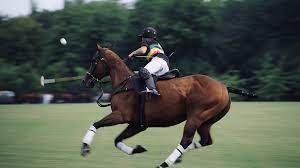While there are many equestrian disciplines, only three are contested in the Summer Olympics: dressage, eventing, and show jumping. The second modern Olympic Games, or the Games of the II Olympiad took place in 1900 in Paris, France, and featured six horse-related events. Riders and their horses competed in jumping, high jump, long jump, hacks and hunter, mail coach, and polo.
Polo involves teams of four players on horseback trying to score a wooden ball between two goal posts with mallets. It has been part of five Summer Olympics and is considered the oldest of all equestrian sports. It hasn’t appeared at the Olympics since 1936, but the Federation of International Polo (FIP) remains hopeful that it will eventually be part of the Olympic program once again.
Below is a closer look at polo’s Olympic history and the fight to have it designated as an Olympic sport.
1. Debut at the 1900 Games
Polo at the 1900 Paris Games was unlike any of the other four subsequent competitions. Rather than nations competing against each other, the polo tournament featured five mixed teams with competitors from different countries. Riders were also allowed to compete for multiple teams. Overall, only 20 riders from four countries (France, Great Britain, United States, and Mexico) participated in the event.
The Foxhunters Hurlingham won the gold medal after defeating BLO Polo Club Rugby 3-1 in the final of the single elimination tournament. There was no third-place match, so semi-final losers Bagatelle Polo Club de Paris and Mexico National Polo Team, which also included riders from the US, shared the bronze medal.
2. Contested Four More Times
Polo wasn’t included in the 1904 Games, but it returned to the Olympics at the 1908 Games in London. However, only three teams, all of which represented the British Olympic Association, competed. The two English teams (Roehampton and Hurlingham) played in the first match. Roehampton, the winner of the match, advanced to the final, while Hurlingham beat the Ireland national team in a second-chance elimination game to advance to the gold medal game. Roehampton defeated Hurlingham once again to win gold.
Polo wasn’t included in the 1912 Summer Olympics, and the 1916 Summer Olympics were canceled due to the First World War. Great Britain defended its polo gold medal in a larger tournament in 1920, which included teams from Spain, Belgium, and the US. Great Britain defeated Spain 13-11 in the final, while the US won bronze with an 11-3 victory over Belgium in the third-place game. Argentina won the gold medal in the 1924 and 1936 Summer Olympics, the latter of which featured teams from Mexico, Hungary, Great Britain, and Germany.
Although men and women compete alongside each other in the current Olympic equestrian events of dressage, show jumping, and eventing, only men were allowed to participate in the five Olympic polo competitions.
3. Logistical and Financial Difficulties
Polo began to decline in popularity in the mid-1930s, but it was mostly discontinued as an Olympic sport due to logistical and financial challenges. While each team only has four players, each player uses at least six horses per match and some use as many as 12. Individual stables are needed for each of these horses, which means infrastructure costs are incredibly high. It also became difficult and costly for some countries to grow the sport, since polo is played on five-hectare pitches, which is the equivalent of about nine football fields.
It also became difficult to organize Olympic polo competitions. Not every country has access to the 300 horses or necessary infrastructure required to host polo tournaments. It can be too expensive for national teams to transport their own horses to different countries.
4. Demonstration Sport at the 2018 Summer Youth Olympics
Although it has been nearly 90 years since polo was an official Olympic sport, the International Olympic Committee classified it as a recognized sport in 1996 and it was contested as a demonstration sport at the 2018 Summer Youth Olympics in Buenos Aires, Argentina. Twenty-eight riders from 12 countries competed in the event, which was attended by IOC dignitaries, including President of the Organising Committee for the Summer Youth Olympic Games Gerardo Werthein. Athletes represented countries such as Italy, Colombia, Chile, Argentina, and the United Arab Emirates.
5. Fight for Inclusion
Polo was among the 26 new sports up for inclusion at the Tokyo 2020 Summer Olympics. However, only five of those—baseball/softball, karate, skateboarding, surfing, and sports climbing—were added to the Olympic program. Polo fans and the FIP were hopeful the sport would return to the Olympics after a successful showing as a demonstration sport at the 2014 World Equestrian Games.
Despite being passed over for Olympic inclusion, FIP Executive Committee member Dr. Richard T. Caleel said the fact it was longlisted for potential inclusion was “a significant step forwards in our efforts to introduce polo into the Olympic Games.”
